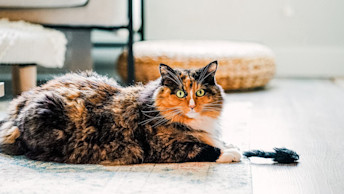February 3, 2021
Fatty Acids: Essential Nutrients for Skin + Coat Health for Cats

Fats are an essential part of your cat’s diet and play a critical role in maintaining healthy skin and a lustrous coat. Fatty acids are the building blocks of fat. Cats require two types of essential fatty acids that they must obtain from their diet: omega-6 and omega-3.
Omega-6
Omega-6 fatty acids play a critical role in skin health by maintaining the outermost water barrier of the skin. Linoleic acid and arachidonic acid are essential omega-6 fatty acids for cats. Chicken fat and canola oil are rich sources of omega-6 fatty acids.
Omega-3
Omega-3’s are polyunsaturated fatty acids that play numerous roles in the body. There are three omega-3 fatty acids that play particularly important roles in supporting your cat’s health: alpha-linolenic acid (ALA), eicosapentaenoic acid (EPA), and docosahexaenoic acid (DHA). ALA is found in oils from plants, such as flaxseed and canola oil. EPA and DHA are found in marine sources, such as salmon, Alaska pollock, and microalgae oil.
Omega 3 & 6 fatty acids in pet food
Most fats and oils are higher in omega-6 than omega-3 fatty acids, but for skin and coat health, cats should receive a balance of both. The role of these fatty acids in maintaining health is affected by the ratio of omega-3 to omega-6, but also the total amount of each in the diet. For kittens and female cats during gestation and lactation, the AAFCO minimum for ALA is 0.02% on a dry matter basis and the minimum for EPA + DHA is 0.012% on a dry matter basis.1
Including both omega-3 and omega-6 fatty acids in your cat’s diet is important because these fatty acids are metabolized by the body into substances that affect inflammation. Omega-3’s are considered less inflammatory than omega-6’s. Too much dietary omega-6 and not enough omega-3 could contribute to a chronic state of low-grade inflammation that is associated with certain diseases such as obesity, cancer, and diabetes. However, too much omega-3 can also cause issues, such as a reduced ability for the blood to clot. So, as with many things when it comes nutrition, while some is good, more is not necessarily better!
Go! Solutions Skin + Coat Care recipes for cats contain a balance of omega-6 and omega-3 fatty acids from premium proteins like chicken, salmon, lamb, duck, turkey, flaxseed, and canola oil to help keep your cat’s skin and coat looking radiant throughout their years.

Recommended Solution
Skin + Coat Care Recipes for Cats
Full of omega-3 fatty acids to hydrate skin, help prevent dandruff and reduce shedding
View Skin + Coat Care recipes
Association of American Feed Control Officials. 2021 Official Publication. Oxford, IN: Association of American Food Control Officials Inc.; 2021.


